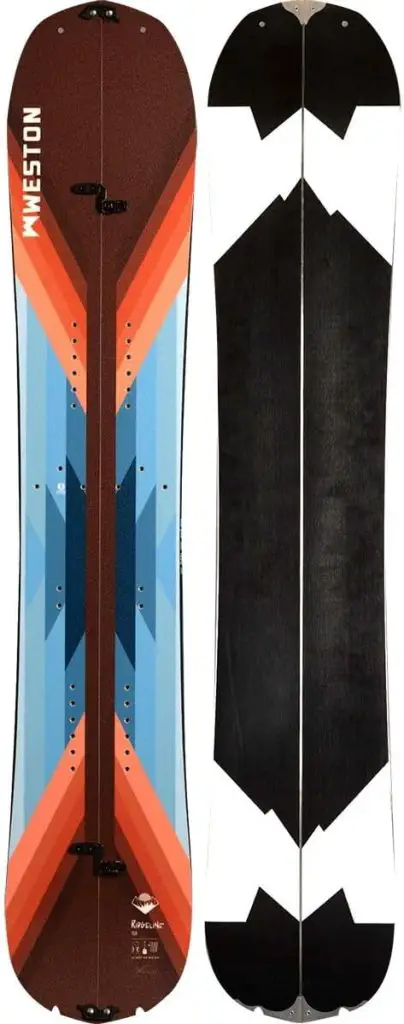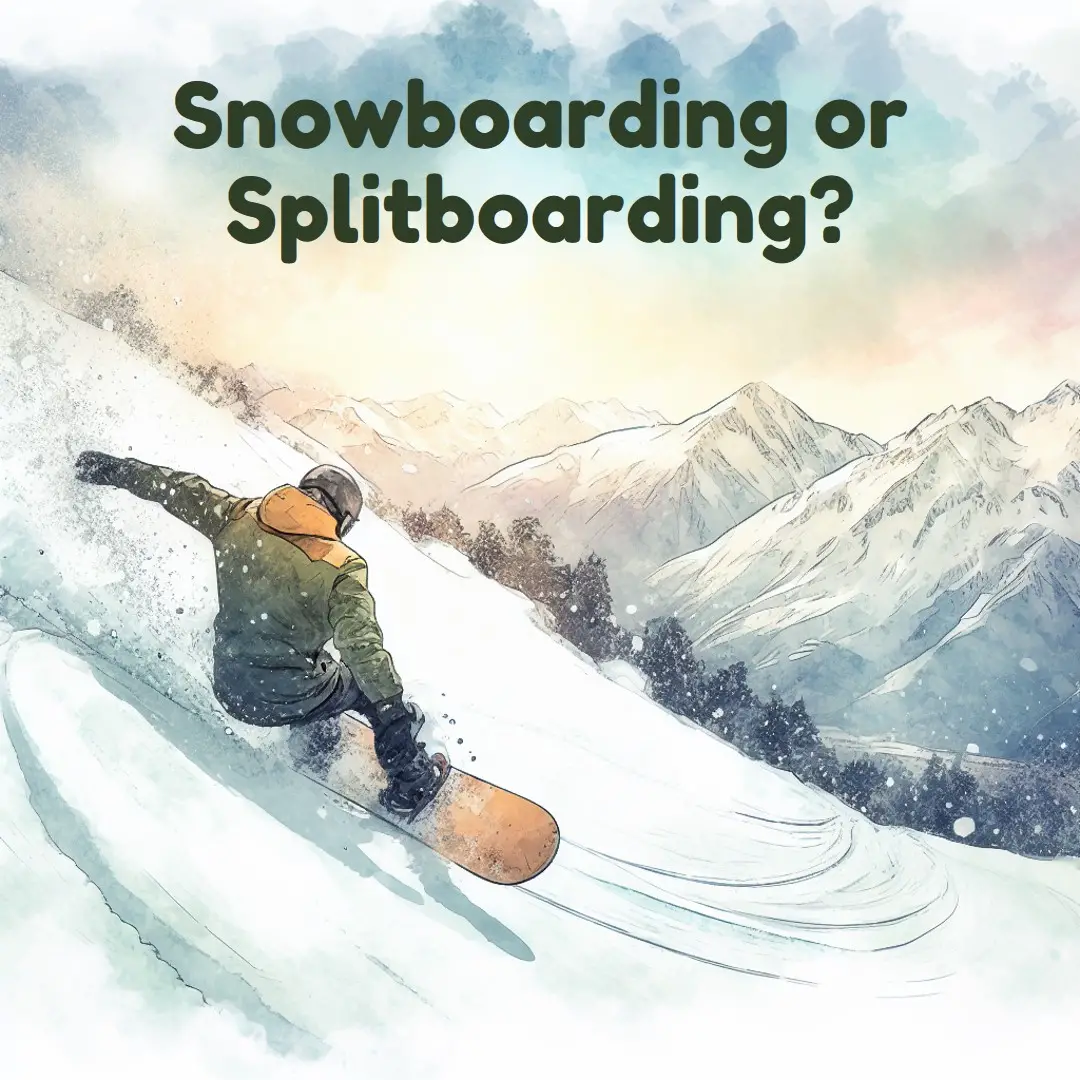Snowboarding is a thrilling winter sport that involves descending snowy slopes on a solid board attached to your feet. Splitboarding takes the sport a step further by using a board that can split in two for the uphill climb, and then lock back together for the downhill ride.
For snowboarding enthusiasts deciding whether to stick with a traditional snowboard or upgrade to a split board, this comprehensive feature-by-feature comparison will cover the key differences, pros and cons, cost considerations, and recommendations to help you decide which is best for your riding needs.
Table of Contents
Overview of Snowboards and Splitboards
Here is a brief introduction to both types of boards we’ll compare:
Snowboard – A solid board made of wood core with a composite exterior ridden downhill. Requires use of ski lifts to reach the top of slopes.
![Best All Mountain Snowboard for Intermediate Reviews 2018 [Must Check]](https://snowboardtravelguide.com/wp-content/uploads/2021/02/Best-All-Mountain-Snowboard-for-Intermediate-Reviews-2018-Must-Check.jpg)
Splitboard – A board that splits lengthwise into two separate halves for touring uphill, then locks together to form a solid snowboard for descending.

Snowboarding originated with solid boards while splitboarding is a more recent innovation that opened up backcountry access. We’ll dive into the unique advantages and tradeoffs of each below.
Weight Difference
One of the most noticeable differences between snowboards and split boards is the weight:
- Snowboards – Typically range from 4-8 lbs depending on size and materials. Very lightweight and easy to maneuver.
- Splitboards – Range from 7-9 lbs including bindings. Heavier than solid boards due to additional hardware.
The splitboard’s extra weight comes from the locking mechanism and pins that allow it to split and pivot. This does make split boards slightly more burdensome and tiring when carrying or maneuvering uphill. But the weight difference riding downhill is negligible.
Price Comparison
Here is a look at the typical price range for each type of board:
Snowboards
- Entry-level – $300 to $400
- Intermediate – $400 to $600
- Advanced – $600 to $800+
Splitboards
- Entry-level – $700 to $800
- Intermediate – $800 to $1200
- Advanced – $1200 to $1500+
Key Differences:
- Splitboards cost nearly 2X more than snowboards at each skill level
- High-end split boards can cost over $1000
- You also need skins for Splitboards adding $100 to $200 to the price
The extra materials and complex manufacturing of splitboards accounts for their higher prices compared to basic snowboards.
Durability Comparison
Here is how snowboards and split boards compare in terms of durability:
Snowboards
- Composite top sheets resist scratches
- P-Tex bottoms hold up well to abrasion
- Metal edges handle rails without damage
- Core materials like poplar are dense and fracture resistant
Splitboards
- Locking mechanisms can wear down over time
- Hinges loosen up with extended use
- Pins can bend or break if abused
- Skins wear down with heavy use
Key Differences:
- Snowboards are extremely durable given their solid construction
- Splitboards have more components that can potentially fail or wear over time
- Splitboard skins need occasional replacement
Standard snowboards are designed to withstand heavy direct impacts and abrasion. The joint mechanisms of splitboards make them slightly more prone to breakdowns.
Performance Comparison
Here’s an overview of the performance differences riding downhill:
Speed
- Snowboards – Allow faster top speeds. Solid construction provides a more aerodynamic profile.
- Splitboards – Generally reach slightly slower maximum speeds due to additional hardware on the board.
Edge Control
- Snowboards – Precise edge control for carving.
- Splitboards – Middle seam can make edge control slightly less precise.
Stability at Speed
- Snowboards – Very stable due to solid platform.
- Splitboards – Potential for some chatter at high speeds over uneven terrain.
Flex
- Snowboards – Designed with customized flex patterns.
- Splitboards – Flex is interrupted by the middle locking seam.
Maneuverability
- Snowboards – Quick edge-to-edge turns. Faster spin tricks.
- Splitboards – Middle connection point affects pivot motions slightly. Slightly slower spins.
Learning Curve
- Snowboards – Easier for complete beginners to learn on.
- Splitboards – Middle joint adds a small learning curve.
The performance differences are relatively small. But traditional snowboards do have some advantages in speed, control, stability and ease of learning.
Uphill Access Comparison
Here is where splitboards distinguish themselves – accessing backcountry terrain:
Snowboards
- Require a ski lift to reach the top of slopes and trails. Cannot hike uphill efficiently.
Splitboards
- Allow traversing uphill terrain via touring or splitboard mode. Opens up backcountry access.
- Skins help grip the snow for climbing.
- Split designs are optimized for ergonomic uphill travel.
Key Advantages of Splitboards:
- Provide access to remote backcountry areas without lift infrastructure.
- Enable launching runs from the precise summit or terrain desired.
- Allow more adventurous lines and routes than accessible via lifts.
For those who prioritize backcountry exploration, splitboarding is by far the superior choice.
Sidecountry Access
“Sidecountry” access involves using a ski lift or gondola to reach the top of patrolled resort boundaries, then hiking and traversing just outside the boundary into adjacent backcountry areas.
For this purpose, splitboards also have advantages:
- Can split to hike ridges just outside resort boundaries.
- Provide access to nearby sidecountry runs and zones from the top of lifts.
- Allow combining groomed runs with nearby sidecountry in a single outing.
Splitboards optimize sidecountry capability as well as longer expeditions.
Glade Access
For accessing heavily treed “glade” areas just off groomed trails, splitboards also excel:
Snowboards
- Can traverse and navigate through sparse trees and wider lines.
- Difficult to walk efficiently through denser trees to access lines.
Splitboards
- Can split into touring mode to traverse dense trees to access lines.
- Enable threading tight trees to reach hidden shots.
- Can split to slowly climb back up to retrace ideal tree lines.
The split design is optimal for venturing into the trees both for the descent and hiking back up.
Binding Differences
Snowboards and splitboards utilize different binding systems:
- Fixed in place under both feet on top of board.
- Usually highback style that attaches at heel and toes.
- Offer lateral flex and shock absorption.
Splitboard Bindings
- Rotate 90 degrees for touring mode.
- Full rotation allows ergonomic climbing motion.
- Sturdier build for handling frequent pivoting.
- Ski-touring style without highbacks.
The specialized splitboard bindings facilitate the crucial transition between downhill and uphill modes.
Boot Differences
Boots are also different between the sports:
- Softer flexing.
- Comfort-focused.
- Vulcanized rubber construction.
Splitboard Boots
- Stiffer sole for better power transfer when touring.
- Communicate board flex more directly.
- Often use lasting boards for lateral rigidity.
Stiffer boots optimize power delivery when climbing on the split configuration.
Skill Level Comparison
Here is a look at the skill levels associated with each sport:
Snowboarding Skill Levels
- Beginner
- Intermediate
- Advanced
- Expert
Splitboarding Skill Levels
- Intermediate snowboarder skills required
- Advanced snowboarder skills recommended
- Additional backcountry skills – orienteering, avalanche awareness
Key Differences:
- Snowboarding can be learned by complete beginners.
- Splitboarding requires intermediate snowboarding proficiency.
- Backcountry skills are highly recommended for splitboarding.
The additional complexity of splitboards means beginners should master snowboarding first before transitioning to splitboarding.
Backcountry Safety Considerations
Due to accessing remote backcountry areas, splitboarding does involve some additional safety considerations:
- Carrying proper survival gear – shovel, probe, radio, etc.
- Checking avalanche reports and conditions.
- Having skills to evaluate terrain and hazards.
- Knowing procedures if caught in an avalanche.
- Understanding wilderness medical training.
Avalanche awareness courses tailored to splitboarders are highly recommended before backcountry riding.
Pros and Cons Comparison
Here is a summary of the key pros and cons for snowboards vs. splitboards:
Snowboards
Pros
- Lower cost
- Lighter weight
- Smoother downhill performance
- Easier to learn
Cons
- Unable to hike uphill efficiently
- Limited to groomed trails and lifts
Splitboards
Pros
- Allow backcountry access
- Split for uphill climbing
- Open up more terrain
- Fun exploration capability
Cons
- Heavier and costlier
- Potential durability issues
- Require intermediate skill level
- Backcountry safety knowledge needed
Key Considerations:
- Snowboards excel at resort riding but can’t access backcountry areas
- Splitboards enable backcountry access but have a learning curve and higher cost
Choose based on your priorities for type of terrain and dedicated backcountry access vs. resort-focused riding.
Recommendations
Here are some final recommendations on whether a snowboard or splitboard is the better choice:
For resort-focused use – Traditional snowboards are better with their lower cost and smoother riding performance on groomed runs.
For backcountry access – Splitboards provide unique access to backcountry terrain outside ski lift serviced areas.
For sidecountry use – Splitboards allow you to traverse from a lift into nearby sidecountry areas.
For deep powder – Splitboards make it easier to reach untouched snow.
For trees/glades – Splitboard mode excels for hiking into densely treed zones.
To progress from resorts – Splitboarding opens up new off-piste challenges once you master groomed trails.
Assess your priorities for cost, backcountry access, powder, trees, and progression to choose the board that fits your riding style and goals.
Comparison Chart
Snowboard
| Attributes | Snowboard | Splitboard |
|---|---|---|
| Weight | 4-8 lbs | 7-9 lbs |
| Price | $300-$800+ | $700-$1500+ |
| Uphill Access | No – requires lifts | Yes – split mode |
| Downhill Performance | Faster, more responsive | Slightly slower, some chatter |
| Skill Required | Beginner – Expert | Intermediate – Expert |
| Terrain | Resorts, groomed trails | Backcountry, sidecountry |
| Safety Gear | Standard protective gear | Backcountry kit recommended |
Conclusion
While splitboards require a larger investment and learning curve, the ability to access untouched backcountry terrain makes them an enticing progression for intermediate and advanced riders looking to expand their horizons beyond resort boundaries.
Carefully assess your skill level, budget, riding preferences, and performance goals when deciding between a traditional snowboard or upgrade to a splitboard. Splitting your time between the two is also a great option. But for committed backcountry enthusiasts, the versatility of splitboards can open up a whole new world of exciting lines and terrain to explore.
